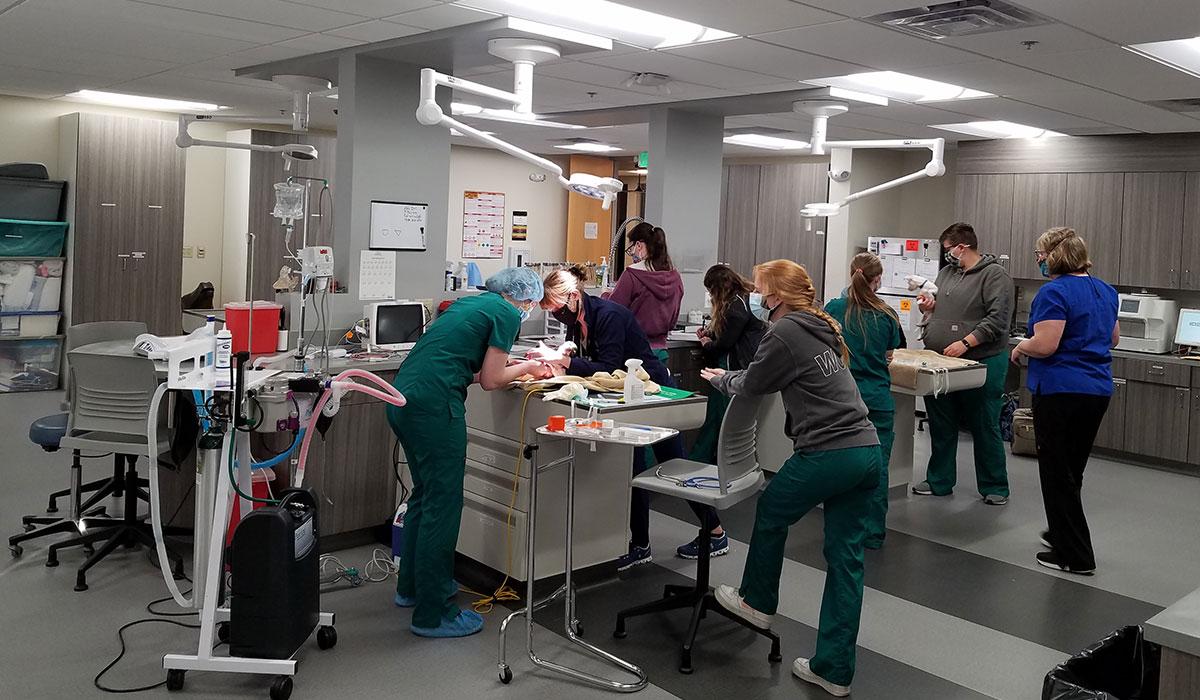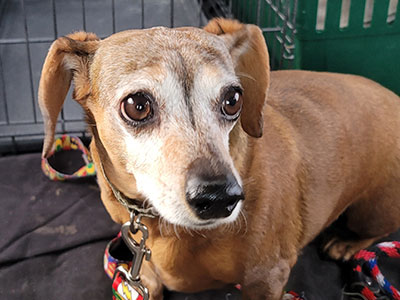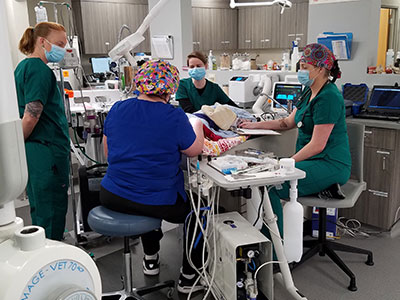
Bogey is an 8-year old dachshund who lost his home when his owner passed away. He was taken in by a local rescue organization, Res-Que, when it became clear that he wouldn’t fit into another household, which included other animals. “The new owners felt guilty that he wasn’t getting enough attention in their home,” explained Karen Vigil, owner of Res-Que.
Res-Que places 200–250 dogs per year into foster and then forever homes, but cases like Bogey—a quiet and sweet older dog—pose a unique challenge. At his age, his teeth were in need of dental care. That, however, is a considerable barrier: dental care for animals, like dental care for humans, isn’t cheap and requires organizations like Res-Que to fundraise for the care that Bogey needed, given that it was highly unlikely that new owners could afford to shoulder the cost.

TMCC Veterinary Nursing students provided Bogey with dental care that enabled him to find his forever home.
“We didn’t realize his teeth were as bad as they were,” Vigil said. While this isn’t exactly a unique situation, it is nonetheless detrimental to older rescue dogs like Bogey.
According to TMCC Veterinary Nursing Instructor Julie McMahon, who is a Veterinary Technician Specialist in dentistry with years of experience in the field, these kinds of issues deeply impact an animal’s quality of life. “The average animal doesn’t get their teeth brushed on a daily basis. [In other words,] there’s little or no home care for animals,” McMahon explained. “Statistically, 80% of animals over the age of three have some form of periodontal disease already.”
The impact of this is two-fold: just like humans, animals who have long-term chronic infections suffer the ill effects in the form of liver and kidney function, and also inflammation of the heart, which can lead to heart disease. For rescue dogs like Bogey, these major health issues can impact the likelihood of finding a forever home.
“It’s nice to be able to help animals, but with dental procedures, it can be very expensive,” said Veterinary Nursing Program Director Michele Noreen. “If a rescue organization takes in a dog like Bogey, usually the adoption fee for the new owner will cover some of the expenses they had. But, if you’re looking at going to an animal hospital and having $1,000 of dental work done, nobody’s going to adopt an older dog for $1,000 in order to make that money back. In that respect, animal rescue is really a labor of love.”
Recently, second-year TMCC Veterinary Nursing students, under McMahon’s direction, provided Bogey with the dental services he needed as a part of their clinical experience. Bogey’s dental health is much improved, but without the hefty price tag. Because of the services that TMCC Veterinary Nursing students provided, one week later Bogey found his forever home. Another bonus: students gained experience that they will use in their careers.
Adding A New Focus
McMahon can hardly remember a time when she wasn’t involved in veterinary care in some way. “I’ve been in the field since 1987. I grew up next door to a hospital, cleaning cages and doing grunt work... then stayed in the practice for another 15 years,” she said. “I was literally a kid when I started. I remember I’d be swimming in the river in the morning and then literally go to work at a veterinary hospital in the afternoon.”
McMahon continued working with animals as a technician at another practice under a veterinarian who was working on his dental specialty.
“At that point in my career, I was in school to become a dental hygienist. And [the veterinarian] I worked for asked me if I knew there was a specialty in dentistry for technicians, and if I was interested in pursuing it.” McMahon took that path, with the hospital where she worked supporting her journey.
Becoming a “specialist” isn’t the same as becoming a Veterinary Nurse; obtaining your initial education and certification enables you to gain an entry-level position. In order to specialize in something like dentistry, those interested have to continue their learning with additional clinical experience and demonstration of the new skills acquired over a period of time.
McMahon finished her training in 2008 and worked as a Veterinary Technician Specialist in dentistry until 2013. Although she’s taught on and off in the Veterinary Nursing program since 2008, it wasn’t until last year that she became a full-time instructor in the program.
“The second-year students finished up their dentistry class in Fall 2020,” she explained. “In that class, they learn the anatomy and physiology of oral disease as well as prevention and treatment. We teach them how to perform basic prophylaxis and cleaning the teeth effectively. So that when the animals do come in...we are doing the best job that we can for them.”
New Spaces for the Veterinary Nursing Program
In addition to opening students’ eyes to the various specializations in this career, the Veterinary Nursing program is continuing to appreciate its new location at the Meadowood Center. “The [new space] is amazing,” said McMahon. “In the sense of dealing with everything with COVID-19, we are fortunate to have a nice, large space to work in with our students.”
Beyond that, the new space offers students, faculty, and staff the ability to function as a full-service veterinary clinic with the proper equipment and materials to help rescue animals like Bogey while providing students with real-life, hands-on experience. The relocation project, which began in 2019 thanks to a generous $500,000 matching grant from the William N. Pennington Foundation, has enabled the Veterinary Nursing program to grow while adding “real life” hospital spaces, including a surgery room, x-ray room, exam room, and a reception area. The Pennington grant was successfully matched thanks to the generosity of nearly 90 donors in our community. In addition to the new space, Veterinary Nursing students now have the opportunity to apply for generous scholarships designated for their program, thanks again to the William N. Pennington Foundation.

The new space for the Veterinary Nursing Program at Meadowood has opened opportunities for students to experience hands-on clinical experience that benefit local rescue animals.
Before the move to the Meadowood Center, the Veterinary Nursing program shared spaces with other allied health programs. “It’s wonderful having our own space,” said McMahon. “It’s allowed us to make more connections with local rescue [organizations] and service more animals than we would have been able to do before.”
“I hope at some point we can have an open house to invite the community to see what we’ve been able to enjoy over the past year,” said McMahon.
However, before you pick up your phone to call the Veterinary Nursing program, it’s important to know that these services are only for rescue organizations, and not for the general public. Given the number of older animals in need of medical and dental care—and forever homes—this is how the Veterinary Nursing program can really provide a much-needed service to our community.
“The fact that we can help these rescue organizations... that’s really beneficial, all-around,” said Noreen.
For more information about the Veterinary Nursing Program, contact the department at 775-824-8660.






